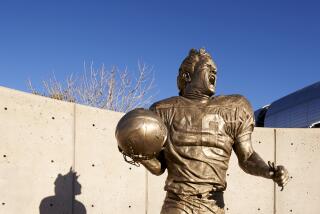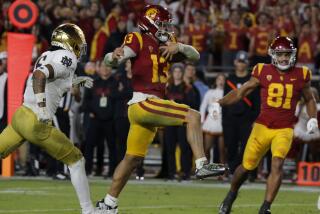Political Football and the Fighting Irish
I attended the University of Notre Dame during its days of glory in the mid- and late-1940s. Frank Leahy was the head football coach in those days, and we never lost a game.
There was one heart-breaking tie between Notre Dame and Army, in 1946. I walked all the way from South Bend, Ind., to New York City to see that game. Of course, I was on a special student-chartered train, but none of us ever sat down through the whole nightâs trip. We marched up and down the aisles, singing and chanting, âCheer, cheer for old Notre Dame.â
We arrived at Grand Central Station just at dawn and surged up the street to St. Patrickâs Cathedral, where we prayed for success for that day.
Actually we hadnât paid close enough attention to Coach Leahyâs response to a reporter from Time magazine who had asked Leahy how much the prayers of all those nuns in those days helped his team. He had replied, âThe prayers work better when the players are bigger.â That was probably the most honest statement he ever gave. As an interviewee, he was not arrow-straight.
The game in Yankee Stadium was a fizzle: 0-0. The whole game was fought out on the 50-yard line. Leahy had apparently spent the week in devising defenses against Glenn Davis and Felix (Doc) Blanchard, Armyâs famed Mr. Outside and Mr. Inside; Army coach Red Blake had planned defenses against Notre Dameâs T-formation. It was trench warfare, the kind of thing you expected from Minnesota.
Things were usually different. Under Coach Leahy, Notre Dame just won. But the home games were so special. In those days the campus was ringed with railroad sidings, and dozens of trains with hundreds of exuberant fans arrived for the Saturday game. Many of them had walked all night, too.
And from Chicago came the Subway Alumni in cars to park and party around the vast expanse of Notre Dame Stadium--a stadium designed only for football: no silly track; this was a football stadium. And the field was sodded with sod imported from Ireland. When the Fighting Irish played at home, they played on the Ould Sod, the real thing.
Then as now, the university was concerned about its academic image, and so classes were held on the Saturday mornings of home games. While thousands of detrained fans roamed the campus, the profs kept on. Even as excited alums bumbled into the classroom to say, âHere I sat,â the Prof would continue, âAs for Ockhamâs razor, we can see now. . . .â
It was an enriching experience.
The football weekend began on Friday evening. In the great, French Gothic Chapel of the Sacred Heart we would gather for benediction. As many of us as could crowd into the chapel would kneel and stand and kneel again amid rising incense and Latin hymns and chanted prayers.
At the end of the service, after the priest had returned the host from the monstrance to the tabernacle, we would rise and sing the concluding hymn in English: âHoly God, we praise thy name.â Only it went, âHoooly Gawd we praaaise thy name.â And then there came a sudden, always unanticipated, always heart-stopping sound from the back of the church. âBoom! Boom! Boom!â
During the service, the Notre Dame Marching Band would creep into the foyer of the church, and wait there in silence until the final hymn. The boom of the big bass drum meant that the football weekend had begun. The hymn segued into the Notre Dame Fight Song: âThe march is on / No brave or brawn / Can stop the charge of fighting men.â
We poured out the church and followed the band across the darkened campus to the Field House--not the glitzy thing they have now. No, this was a real field house with an earthen floor and a balcony. And on every Friday night of every home game that balcony was crowded with every Irish politician from the eastern banks of the Mississippi to the Eastern Seaboard--if they could swing the invitation. There were governors and mayors and representatives and senators and assemblymen and aldermen and council members.
First the master of ceremonies, a senior cut-up, would introduce the football players. He had one-liners but we would laugh and applaud before he got them off. A Fighting Irish with a Polish name, Johnny Lujack or Frank Tripuka, would convulse the whole crowd. And then he would introduce the Irish politicians. Their speeches were short and pointed: God was on the side of Notre Dame just as he was on the politiciansâ side in the up-coming elections. Applause, laughter, and a few, very few, cat-calls.
And finally Coach Leahy would be introduced. He could tell a good joke--after all, he spent half the year on the banquet tour--but he had such a dour face and such a pessimistic attitude. Year after year we expected him to break into a knowing grin, but he never did.
He told the whole wild assembly that Notre Dame didnât have a chance on Saturday. The other team was stronger and faster, and worse than that, better coached. That inevitable speech had the same effect as the invariable and unanticipated boom at the back of the church. It drove us wild; cheers and shouts, the pummeling of oneâs neighbor; the whole crowded balcony on its feet crowing the promise of success.
I think back now and try to understand what kind of intense political negotiations must have gone on to allow an Irish public servant to stand on the balcony of the Fighting Irishâs field house with the whole football team and Coach Leahy and God on the eve of an inevitable Irish victory.
I have a hint on how tough the competition was. I was graduated from Notre Dame on one of those off-season graduations. It was postwar, and the university was clearing out veterans with odd units. So our graduation was in the midst of a January blizzard and the graduation speaker was a young representative from Massachusetts whose father was a great friend of the president of the university, yet all he could wangle was a job as commencement speaker, not a place on that balcony during a Friday night pep rally. That was John F. Kennedy.
More to Read
Go beyond the scoreboard
Get the latest on L.A.'s teams in the daily Sports Report newsletter.
You may occasionally receive promotional content from the Los Angeles Times.










